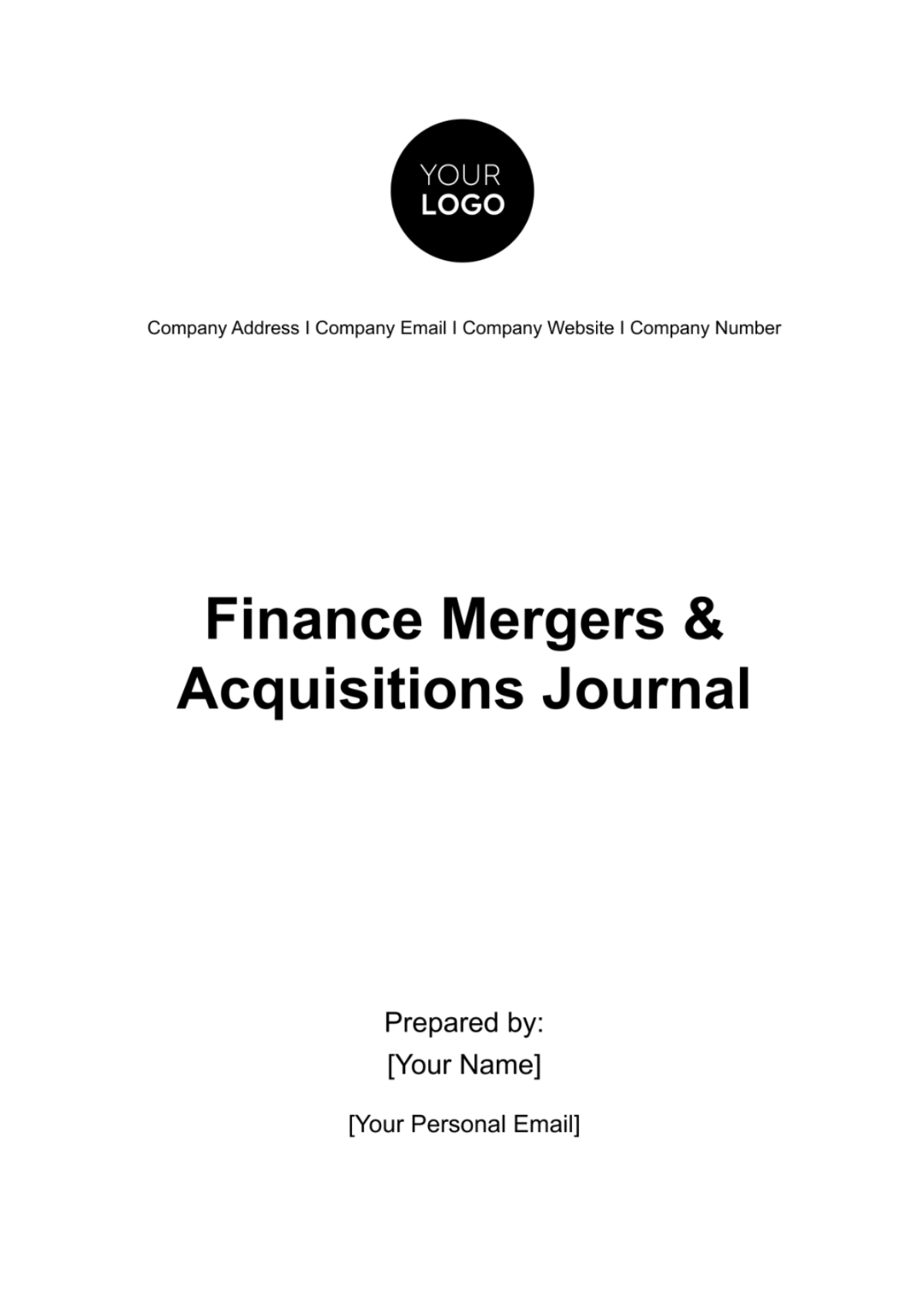Free Finance Mergers & Acquisitions Journal

TABLE OF CONTENTS
I. Market Overview and Trends
II. Regulatory Environment and Compliance
A. Recent Regulatory Developments and Their Impact
B. Compliance Strategies for Successful Transactions
III. Financial Analysis and Valuation Techniques
A. Valuation Methods Specific to M&A
B. Financial Due Diligence Best Practices
IV. Integration and Post-Merger Strategies
A. Successful Integration Post-Merger
B. Measuring Post-Merger Success
V. Case Studies and Real-world Examples
A. Successful M&A Stories
B. Lessons from Failed Mergers
I. Market Overview and Trends
Global Market Conditions and M&A
In this comprehensive exploration, we assess how global market conditions are influencing M&A activities. We delve into the intricate interplay of economic trends, political climates, and technological advancements shaping the M&A landscape. By conducting a nuanced analysis across diverse regions such as North America's mature markets, Europe's policy-driven environments, Asia's rapid growth sectors, and the unique opportunities in emerging economies, this section offers a multifaceted perspective on how global dynamics are redefining the strategies and outcomes of M&A transactions.
Emerging Strategies and Methodologies in M&A
The dynamic nature of the business world today demands innovative and adaptive M&A strategies. In this detailed analysis, we explore cutting-edge approaches revolutionizing M&A processes. We focus on the integration of artificial intelligence in streamlining due diligence, enhancing accuracy, and predicting post-merger integration challenges. The growing relevance of cross-border transactions is examined, highlighting how they diversify portfolios and mitigate regional risks. Additionally, this section underscores the critical role of digital transformation in M&A, from automating processes to enhancing data analytics, thereby driving more informed decision-making and strategic planning in M&A initiatives.
Sustainability and ESG in M&A Decisions
This segment delves into the increasingly significant role of Environmental, Social, and Governance (ESG) considerations in shaping M&A decisions. We explore how integrating ESG factors is not just a moral imperative but a strategic business move, contributing to long-term value creation. The discussion encompasses how companies are increasingly scrutinizing potential M&A deals for ESG compliance, the impact of ESG on deal valuation, and risk assessment. We also examine case studies where ESG-aligned M&A strategies have led to enhanced brand reputation, customer loyalty, and operational efficiencies, demonstrating that sustainable practices are becoming integral to successful M&A outcomes.
II. Regulatory Environment and Compliance
Navigating the complex regulatory landscape is critical in M&A transactions. This section offers a deep dive into the latest regulatory changes across key markets and their implications for M&A. It also provides strategic insights into developing robust compliance strategies, accompanied by real-life case studies demonstrating the consequences of non-compliance and best practices for mitigating regulatory risks.
A. Recent Regulatory Developments and Their Impact
The landscape of mergers and acquisitions is continually reshaped by evolving regulatory frameworks. In the European Union, recent amendments to the EU Merger Regulation focus on streamlining the review process for non-problematic cases, thereby expediting transactions. In contrast, the United States has seen a tightening of scrutiny under the Hart-Scott-Rodino Antitrust Improvements Act, especially in tech and pharmaceutical sectors, challenging companies to rethink their consolidation strategies.
Meanwhile, in Asia, with a specific focus on China, regulatory reforms have been geared towards greater transparency and fairness in foreign investments, affecting cross-border M&A activities. These diverse regulatory shifts significantly impact how companies approach due diligence, valuation, and even target selection, making it imperative for M&A strategists to adapt to each jurisdiction's unique regulatory landscape.
B. Compliance Strategies for Successful Transactions
Effective compliance strategies are the backbone of successful M&A transactions. To navigate the complex web of regulations, a multi-pronged approach is necessary.
Firstly, establishing a robust internal compliance team, well-versed in both local and international laws, is crucial. For instance, a multinational merger might require adherence to the U.S. Foreign Corrupt Practices Act and the EU's General Data Protection Regulation simultaneously.
Secondly, leveraging technology for compliance management can significantly reduce risks and improve efficiency. Tools like automated compliance checklists and AI-driven risk assessment algorithms can provide real-time insights. Thirdly, lessons from past case studies, like the failed merger between two leading tech giants due to antitrust concerns, highlight the importance of early engagement with regulatory bodies.
Such proactive communication can preempt major legal hurdles and streamline the approval process. Lastly, fostering a culture of compliance within the organization, from the top management down, ensures that regulatory adherence is an integral part of the company's M&A strategy.
III. Financial Analysis and Valuation Techniques
Financial analysis and valuation techniques are crucial for informing decision-making and ensuring successful outcomes. This section provides a comprehensive overview of various valuation methods specifically tailored for M&A transactions, accompanied by real-world applications. It also delves into the best practices for financial due diligence, highlighting key aspects crucial for evaluating the financial health and potential of target companies.
A. Valuation Methods Specific to M&A
An in-depth exploration of various valuation techniques tailored for M&A, including discounted cash flow analysis, comparative company analysis, and precedent transactions. This section is enriched with case studies demonstrating the application of these methods in real-world scenarios.
Valuation Technique | Description | Application in M&A |
Discounted Cash Flow (DCF) Analysis | Estimating the value of an investment based on its expected future cash flows, adjusted for time value of money. | Useful for evaluating profitability and future growth potential of a target company. |
Comparative Company Analysis (CCA) | Assessing a company's value by comparing it with similar companies in terms of size, growth, and profitability. | Helps in benchmarking and determining relative valuation in an industry context. |
Precedent Transactions Analysis | Valuing a company based on past M&A transactions of similar companies in the same industry. | Provides insights into market trends and historical transaction valuations. |
Leveraged Buyout (LBO) Analysis | Determining the potential return on an investment when a significant portion of the purchase price is financed through borrowing. | Common in private equity transactions to assess the feasibility of high debt levels. |
Real Options Valuation | Considering the value of future investment opportunities within the target company. | Useful for companies with significant growth potential or strategic investments. |
B. Financial Due Diligence Best Practices
Financial due diligence is the cornerstone of successful M&A. This segment covers the key aspects of financial due diligence, from assessing the target company's financial health to identifying potential risks and synergies. It also outlines the best practices and methodologies to conduct thorough financial analysis.
Key Aspect | Description |
Financial Statement Analysis | In-depth examination of financial statements to assess the company's financial health, revenue trends, profitability, and cash flow stability. |
Debt and Liabilities Review | Assessing the target company's debt structure, including long-term and short-term liabilities, to understand financial risks. |
Asset Valuation | Evaluating the worth of tangible and intangible assets to ensure they are not overvalued or undervalued in the transaction. |
Operational Performance Review | Analyzing the efficiency and effectiveness of the company's operations, including cost structures and revenue generation capabilities. |
Future Earnings Projections | Forecasting future earnings to understand the growth potential and sustainability of the target company's business model. |
IV. Integration and Post-Merger Strategies
Mergers and acquisitions don't end with a signed deal; their success often hinges on effective post-merger integration and ongoing performance evaluation. This section provides a comprehensive look at the critical strategies for successful integration post-merger and outlines key metrics and KPIs for measuring post-merger success, offering insights into ensuring long-term value creation from M&A activities.
A. Successful Integration Post-Merger
Effective integration post-merger is a critical phase in the M&A process, where the real work of merging two distinct entities begins. This phase is about harmonizing cultures, aligning systems, and achieving operational synergies. Here are some strategies and insights on how to navigate this complex phase effectively:
Cultural Alignment: One of the most significant challenges in post-merger integration is aligning the cultures of two different organizations. To address this, it's crucial to establish a unified vision and shared values from the outset. This can be achieved through leadership workshops, employee engagement initiatives, and open communication channels. A case study worth noting is the Daimler-Chrysler merger, where cultural clashes were a major factor in the merger's difficulties. Lessons from this case highlight the importance of cultural due diligence and the development of a cohesive culture post-merger.
System Integration: Another key aspect is the integration of systems - from IT infrastructure to operational processes. A strategic approach here involves conducting a thorough audit of both companies' systems, identifying overlaps and gaps, and then creating a roadmap for integration. Utilizing transitional service agreements can be beneficial in smoothing the process. Expert opinions suggest that early and continuous engagement with IT staff and end-users is vital to ensure a smooth transition and to address any technical challenges promptly.
Achieving Operational Synergies: Operational synergies are often the primary driver behind M&As. To achieve these synergies, companies should focus on consolidating operations where possible, such as merging supply chains or streamlining customer service functions. However, it's essential to maintain a balance between achieving efficiencies and preserving the unique strengths of each company. A practical approach is to set up cross-functional teams to identify synergy opportunities and implement best practices from both entities.
Challenges in post-merger integration are inevitable. Resistance to change is a common issue, which can be mitigated through effective change management strategies, including regular communication, involving employees in the integration process, and providing training and support. Another challenge is maintaining business continuity during integration. This can be addressed by having a detailed integration plan, phased implementation, and contingency plans in place.
B. Measuring Post-Merger Success
Assessing the success of M&A activities involves a careful analysis of various metrics and Key Performance Indicators (KPIs). These metrics provide insights into whether the merger or acquisition has achieved its intended goals. Alongside, strategies for sustained growth and value creation are essential to maximize the long-term benefits of the merger. Here's an outline of the key metrics, KPIs, and strategies:
Metrics and KPIs Essential for Assessing M&A Success
Revenue Growth: Post-merger revenue growth is a primary indicator of success. It shows how effectively the merged entity can capitalize on market opportunities.
Cost Synergies: Realized cost savings from operational efficiencies are vital. This includes reductions in overheads, streamlined supply chains, and consolidated administrative functions.
Earnings Before Interest, Taxes, Depreciation, and Amortization (EBITDA): EBITDA margins post-merger are crucial for understanding the financial health and operational efficiency of the combined entity.
Return on Investment (ROI): This measures the financial return relative to the cost of the acquisition, indicating if the M&A has added financial value.
Market Share: An increase in market share post-merger indicates successful market penetration and competitive advantage.
Employee Retention and Engagement: High retention and engagement levels post-merger signal a successful cultural integration, which is key to long-term success.
Customer Retention and Satisfaction: Maintaining or improving customer satisfaction and retention rates post-merger is essential, as it reflects on the entity's market reputation and service quality.
Strategies for Sustained Growth and Value Creation
Continuous Market Analysis: Regularly analyzing market trends and customer needs to adapt and innovate is crucial for sustained growth.
Investment in Technology and Innovation: Post-merger, investing in new technologies and innovation can create new revenue streams and improve operational efficiencies.
Cultural Integration: Fostering a unified company culture ensures smoother operations and employee satisfaction, which is vital for long-term success.
Customer-Centric Approach: Continuously enhancing customer experience and engagement to retain and grow the customer base.
Strategic Investment and Divestment: Identifying areas for strategic investment for growth and divesting non-core or underperforming assets to streamline the business.
Leadership and Talent Development: Investing in leadership and employee development to build a strong team capable of driving the company forward.
Performance Monitoring: Regularly reviewing the set KPIs and adjusting strategies as necessary to stay on track with the merger's objectives.
By focusing on these metrics and KPIs, and implementing strategies for sustained growth and value creation, companies can ensure that their M&A activities not only meet short-term objectives but also contribute to long-term success and profitability.
V. Case Studies and Real-world Examples
In this section, we present an insightful collection of case studies, showcasing both successful and failed M&A transactions. Through these real-world examples, we dissect the strategies and pitfalls, providing valuable lessons and practical insights. This comparative analysis helps in understanding the dynamics of successful mergers and learning from the missteps of failed ones.
A. Successful M&A Stories
Here, we analyze several successful M&A deals, dissecting the strategies that led to their success. These real-world examples provide practical insights and lessons that can be applied in future M&A transactions.
Company Names | Industry | Year | Key Success Factors | Outcome |
Disney and Pixar | Entertainment | 2006 | Strategic fit, cultural alignment, retaining Pixar's creative independence | Significant growth in animation dominance, increased revenue and market share |
Exxon and Mobil | Oil and Gas | 1999 | Complementary strengths, effective integration, cost synergies | Created world's largest publicly traded oil company, substantial increase in market value |
Google and Android | Technology | 2005 | Visionary acquisition, leveraging Google's resources, market foresight | Dominance in mobile operating systems, significant revenue growth from mobile advertising |
Amazon and Whole Foods | Retail | 2017 | Expansion into brick-and-mortar, synergy in technology and customer base, brand value alignment | Enhanced market presence in grocery retail, growth in customer base and revenue streams |
Microsoft and LinkedIn | Technology /Social Media | 2016 | Data integration, platform synergies, growth in professional cloud services | Strengthened Microsoft's position in professional networking and cloud services, increased user engagement |
B. Lessons from Failed Mergers
Understanding the pitfalls is as important as recognizing the success factors. This section examines some of the notable failed mergers, analyzing the reasons behind their failure and the lessons that can be learned from these experiences.
Company Names | Industry | Year | Key Failure Factors | Lessons Learned |
AOL and Time Warner | Media/Internet | 2000 | Cultural clashes, overestimation of synergies, failure to adapt to market changes | Importance of cultural compatibility, realistic synergy assessment, need for adaptive business models |
Daimler-Benz and Chrysler | Automotive | 1998 | Strategic misalignment, cultural differences, management conflicts | Necessity of strategic compatibility, importance of managing cultural integration, need for aligned leadership |
HP and Autonomy | Technology | 2011 | Overvaluation, lack of due diligence, mismanagement of integration | Rigor in financial due diligence, careful integration planning, effective post-merger management |
Sprint and Nextel | Telecommunications | 2005 | Incompatible technologies, cultural misalignment, poor integration execution | Importance of technological compatibility, effective communication strategies, thorough integration planning |
eBay and Skype | E-commerce/ Telecommunications | 2005 | Misaligned business models, overestimation of synergies, lack of strategic focus | Importance of aligning core business models, realistic evaluation of potential synergies, maintaining strategic focus |
- 100% Customizable, free editor
- Access 1 Million+ Templates, photo’s & graphics
- Download or share as a template
- Click and replace photos, graphics, text, backgrounds
- Resize, crop, AI write & more
- Access advanced editor
Dive into the financial world with Template.net's Finance Mergers & Acquisitions Journal, expertly created for your sophisticated needs. Fully editable and customizable, navigate complex negotiations confidently. Effortlessly modify in our Ai Editor Tool. Absorb, analyse, and act upon key insights. Propel your financial success forward. Stay ahead, start using this template today.





























